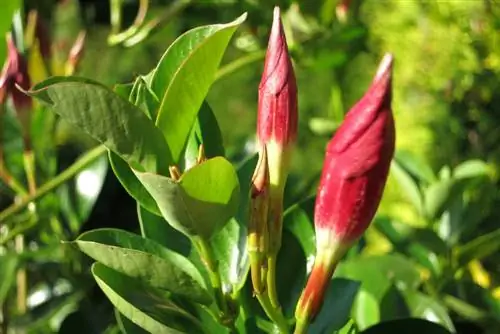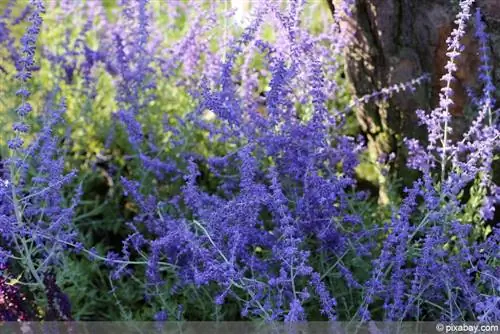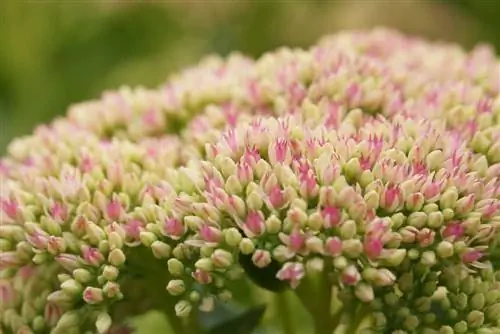- Author admin [email protected].
- Public 2023-12-17 03:39.
- Last modified 2025-06-01 06:48.
Whether in the apartment all year round or on the terrace or balcony in summer, the beautiful funnel flowers of the Dipladenia delight every plant lover. For the frost-sensitive tropical plant that comes from Central and South America, the secateurs should be used at least once a year. After pruning, the plant sprouts again vigorously.
When to cut back the Dipladenia?
There is a particularly suitable time for pruning for Dipladenia from the dogpoison family, with slight deviations if necessary:
- best time for cutting: early spring
- possibly just shorten the long tendrils in autumn
- Repruning in spring
Why cut the Dipladenia?
Growns from the trade are often treated with compressing agents that dampen the growth of the plant. If the effect of these preparations wears off, dipladenia with a previously squat shape experience an enormous upward push. If there is not enough space, the scissors have to be used. The reasons for blending in detail:
- decreasing flowering joy
- Growth too lush (especially when grown indoors)
- more light and air for the individual shoots
- when changing location in autumn: use scissors to remove tendrils from the climbing frame
Types of pruning
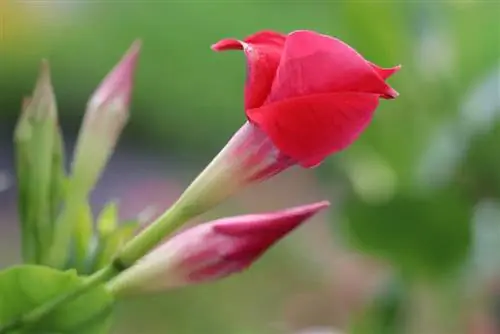
Experience has shown that pruning causes little or no problems, especially since the Dipladenia excretes a viscous liquid from its injuries, which dries and hardens quickly in the air. Because this juice contains antibiotic tannins and alkaloids, the plant is protected from invading germs. In the wild, milky sap has another meaning. Its bitter taste scares away birds and mammals looking for a tasty meal. In summer heat, pruning measures should be avoided, as more milky sap appears during the main vegetation and the injuries take longer to heal. Unless obstructive shoot axes have to give way, the plant needs to grow wider or cuttings are needed
Rejuvenation cut
Pruning is necessary shortly before each new growth at the latest. Flowers only develop on fresh shoots. If you don't cut, flower growth will suffer and the twining climbing plant will also become bald from below. If the plant with the scientific name Mandevilla is to retain its beautiful appearance, a rejuvenation treatment in the form of trimmed shoots is necessary every year.
Pruning for horny growth
If the leaves appear on longer shoots at large intervals during the dark season and remain quite small, this is accelerated linear growth, the so-called yellowing, because the plant stretches towards the brightness. In winter, a cooler location is recommended because heat stimulates growth even though the minimum amount of light is missing. Give your Dipladenia the winter rest it deserves at 5° to 10° C and reduced watering so that it can regenerate and gather enough strength for numerous flowers in the coming season. Rotted shoots are unstable and should be removed as quickly as possible.
Pincing
Shortening the shoot tips during the growth phase results in a more compact appearance. By restricting the tendrils' ability to develop upwards, the plant expands more and more in width. Pinching, as the technical term goes, creates a bushy shape.
Cut back diseased plant parts
Yellow leaves that come off can be classified under biological renewal processes. Dipladenias usually lose some of their foliage in winter. Older branches are probably mainly affected and will be taken into account the next time they are cut. Black dots and spots on the leaves, on the other hand, indicate sooty mold, often as a result of lice infestation, with fungi settling on the insect excretions. You will be doing your Dipladenia a favor if you immediately cut off and dispose of diseased parts of the plant.
Tip:
Diseases usually only occur when there is waterlogging or a location that is too cool or too shady.
Pruning plants affected by pests
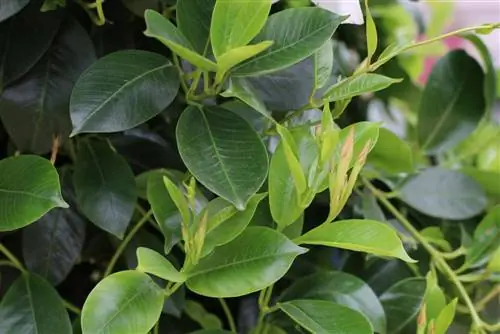
Mainly during hibernation, the Dipladenia may serve as a welcome home for spider mites as well as aphids, scale insects and mealybugs. You can stand up to the pests with pesticides or by spraying a soap and alcohol solution. A radical pruning before spring also brings an abrupt end to the parasites.
Use clippings for cuttings
Green or slightly woody branches, which are produced when pruning anyway, are suitable as offshoots. Cut the cuttings diagonally at the bottom and place them in a pot with well-drained soil. Pour well and cover with foil. However, some patience is required until the cuttings form roots.
Pruner maintenance:
Occasional oiling protects against rust and keeps the tool running smoothly.
Pruning instructions
- If you cut outdoors, it shouldn't rain. In dry weather, cuts heal more quickly.
- Use secateurs with a sharp blade.
- Spread newspaper under and around the plant pot if you are pruning in the apartment or on patio and balcony floors made of wood or natural stone. Escaping milky juice causes stains on carpets, sensitive surfaces and furniture surfaces.
- Put on gardening gloves or other protective gloves. The white, sticky secretion of Dipladenia contains toxic substances.
- When making a rejuvenation cut, the shoots are shortened by half or up to a remaining third. Avoid tearing out the interfaces.
- So that the plant does not grow too high, the cut can be made even more vigorously and extended to the side shoots.
- Always place the scissors 1 - 2 mm above an outward-facing eye.
- Cut off dried, diseased and decayed shoots directly at the base.
- When making a radical cut, make sure that you leave at least two leaf buds on the main shoot.
- If the plant receives a new pot with fresh substrate, you can also cut back long root shoots.
- Despite using gloves, wash your hands thoroughly after completing the task.
- So that the plant recovers quickly after cutting and sprouts new shoots as quickly as possible, it needs favorable lighting conditions and temperatures that are not too cold.

Note:
Be sure to protect yourself from the poisonous latex of the Dipladenia, which comes out of open areas when cutting. Allergic reactions may occur when in contact with sensitive skin.
What errors can occur when cutting?
- blunt secateurs: no accurate cuts
- long wait after winter: late flowering
- pruning too little: tendency to baldness
- Rainy weather: fungus and infection risk
- Bright sun: burn cuts
Warning:
Small children are absolutely out of place when cutting back the Dipladenia. The risk of them putting poisonous plant parts in their mouths would be far too great.
Should faded Dipladenia flowers be cut off?
The delicate scent of the flowers attracts bumblebees and bees. As soon as the insects snack on the sugary nectar, they ensure fertilization. Subsequently, the plant requires a lot of energy to concentrate on developing seeds in pod-like capsules. There isn't much energy left for more flowers. To prevent fatigue from setting in during flowering, the fruiting bodies must not ripen. You don't need scissors for this. Withered flowers can be easily picked off by hand. By always removing wilted flowers, the plant responds by producing new buds until autumn.

